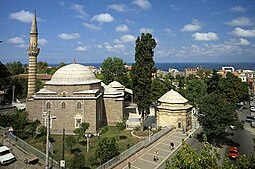Gülbahar Hatun (mother of Selim I)
| Gülbahar Hatun | |||||
|---|---|---|---|---|---|
 The tomb of "Gülbahar Hatun" is located inside "Gülbahar Hatun Mosque" in Trabzon | |||||
| Born | c. 1453 | ||||
| Died | c. 1505 (aged 51–52)[1] Trabzon, Ottoman Empire | ||||
| Burial | |||||
| Consort of | Bayezid II | ||||
| Issue | Selim I | ||||
| |||||
| Religion | Sunni Islam | ||||
Ayşe Gülbahar Hatun[2][3] (Ottoman Turkish: گل بهار خاتون, lit. 'spring rose';[4] c. 1453 – c. 1505),[1] was a concubine of Sultan Bayezid II and the mother of Sultan Selim I of the Ottoman Empire and the grandmother of Sultan Suleiman the Magnificent.[5]
Names
[edit]One of the oldest references Cenabî History gives her name as Ayşe Hatun. According to Sicill-i Osmanî her name is Gülbahar Hatun, while Alderson gives her name as Ayşe Hatun, as well.[1]
Origins
[edit]Although long confused or mistaken with the namesake Ayşe Hatun, daughter of Alaüddevle Bozkurt Bey, the eleventh ruler of the Dulkadirids, this version, based on tradition, has been debunked by archivals and documentals evidences, which has proved that the princess Ayşe Hatun and the concubine Ayşe Gülbahar Hatun were two different consorts of Bayezid II and that the second was Selim I's mother.[6][7][8][9]
The discovery of inscriptions (vakfiye) and others documents where she was called Ayşe Gülbahar bint Abdüllah proves that she had christian slave origins, since this is the traditional formula by which slaves converted to Islam were indicated.[9][10][11][12] However, there are multiple theories as to what her ethnic origin is.
She is occasionally referred to as Albanian, but is believed by most historians that she was a Pontic Greek from the village of Vayvara (south of Sumela Monastery).[13][14][12]
Life
[edit]She entered in Bayezid's harem around 1469 at Amasya. When Bayezid was still a şehzade and the governor of Amasya sanjak when she gave birth to Selim I in 1470.[citation needed] When Mehmed the Conqueror died in 1481, Bayezid moved to Constantinople, the capital of the Ottoman Empire, along with his family to ascend the throne.[citation needed]
According to Turkish tradition, all princes were expected to work as provincial governors (Sanjak-bey) as a part of their training.[12] Mothers of princes were responsible for the proper behaviour of their sons in their provincial posts.[12] In 1495 was sent to Trabzon sanjak and then in 1511 to Samandıra, and Gülbahar accompanied him.[citation needed]
However, she herself never became recognized as a Valide Hatun because she died in 1505 before Selim's accession to the throne.[citation needed] Her tomb is located in Gülbahar Hatun Mosque, Trabzon.[12] It was built in 1514 in honour of his mother and was restored in 1885.[citation needed]
Issue
[edit]By Bayezid II, Gülbahar had a son:
- Selim I (1470 - 1520). He became sultan after dethroning his father and defeating his half-brothers Ahmed and Korkut.
See also
[edit]- Ottoman Empire
- Ottoman family tree
- Ottoman dynasty
- Line of succession to the Ottoman throne
- Ottoman family tree (simplified)
References
[edit]- ^ a b c Necdet Sakaoğlu [in Turkish] (2008). Bu mülkün kadın sultanları: Vâlide sultanlar, hâtunlar, hasekiler, kadınefendiler, sultanefendiler. Oğlak publications. p. 135. ISBN 978-975-329-623-6.
- ^ Diyanet İslâm Ansiklopedisi, vol: 36, pages: 407–414, 2009 (Âişe Hâtun was the daughter of Alaüddevle Bozkurt Bey)
- ^ Bahadıroğlu, Yavuz, Resimli Osmanlı Tarihi, Nesil Yayınları (Ottoman History with Illustrations, Nesil Publications), 15th Ed., 2009, page 157, ISBN 978-975-269-299-2
- ^ Rásonyi, László; Baski, Imre (2007). Onomasticon Turcicum: Turkic Personal Names. Vol. 1. Bloomington, Indiana: Denis Sinor Institute for Inner Asian Studies. p. 274. ISBN 978-0-933070-56-1.
- ^ Ahmed Akgündüz, Said Öztürk (2011). Ottoman History: Misperceptions and Truths. Oxford University Press. ISBN 978-90-90-26108-9.
- ^ Necdet Sakaoğlu [in Turkish] (2008). Bu mülkün kadın sultanları: Vâlide sultanlar, hâtunlar, hasekiler, kadınefendiler, sultanefendiler. Oğlak publications. p. 136. ISBN 978-975-329-623-6.
- ^ "Yavuz Sultan Selim Han". Republic of Turkey Ministry of Culture and Tourism. Archived from the original on 2011-04-17. Retrieved 2009-02-06."Mother Of Yavuz Sultan Selim". Osmanlı Araştırmaları Vakfı (Ottoman Research Foundation). Archived from the original on 2010-12-08.Osmanlıdan Cumhuriyete Trabzonlu simalar ve Trabzon'un köklü aileleri. Mehmet Akif Bal. 2005. ISBN 978-975-00451-0-3.Yakın Çağda Kahramanmaraş. Ukde. 2009. ISBN 978-605-5602-05-5.
- ^ Zamanın İskenderi şarkın Fatihi: Yavuz Sultan Selim. Yitik Hazine Yayınları. 2010. ISBN 978-9944-766-24-1.VII-XVI. asırlarda Maraş emirleri: emir, melik, bey, senyör, beylerbeyi, sancakbeyi. Ukde. 2008. ISBN 978-605-89971-0-3.Amasya. Amasya Ticaret ve Sanayi Odası. 1997.Dijkema, F.TH (1977), The Ottoman Historical Monumental Inscriptions in Edirne, BRILL, p. 32, ISBN 90-04-05062-0
- ^ a b Necdet Sakaoğlu [in Turkish] (2008). Bu mülkün kadın sultanları: Vâlide sultanlar, hâtunlar, hasekiler, kadınefendiler, sultanefendiler. Oğlak publications. p. 136. ISBN 978-975-329-623-6. (Gülbahar binti Abdüssamed was the Ottoman Sultan Bayezid II's eighth wife who had been sent to join his son Selim I, the governor of Trebizond Eyalet).
- ^ "Consorts Of Ottoman Sultans (in Turkish)". Ottoman Web Page.
- ^ Anthony Dolphin Alderson (1956). The Structure of the Ottoman Dynasty. Clarendon Press.
- ^ a b c d e Leslie P. Peirce (1993). The Imperial Harem: Women and Sovereignty in the Ottoman Empire. Oxford University Press. pp. 106–107. ISBN 978-0-19-508677-5.
- ^ "Manastırlar". www.macka.gov.tr (in Turkish). Retrieved 2021-06-24.
- ^ Bahadıroğlu, Yavuz (2007). Resimli Osmanlı tarihi ([10.baskı : Eylül 2007] ed.). İstanbul: Nesil yayınları. p. 157. ISBN 978-975-269-299-2. OCLC 235010971.
- 1450s births
- 1505 deaths
- 15th-century consorts of Ottoman sultans
- 16th-century consorts of Ottoman sultans
- 15th-century slaves from the Ottoman Empire
- 16th-century slaves from the Ottoman Empire
- Concubines of Ottoman sultans
- 15th-century women from the Ottoman Empire
- 16th-century women from the Ottoman Empire
- Mothers of Ottoman sultans
